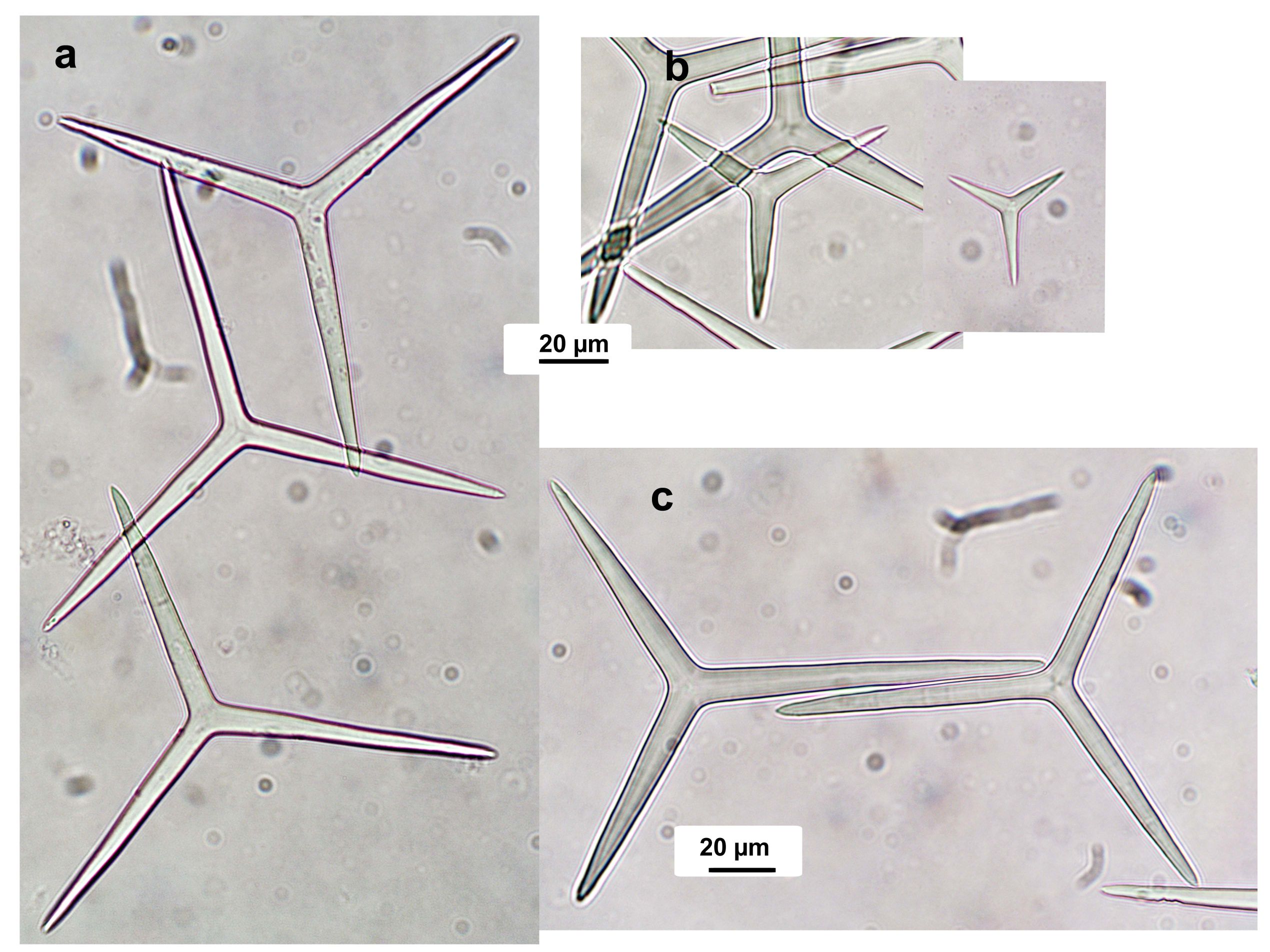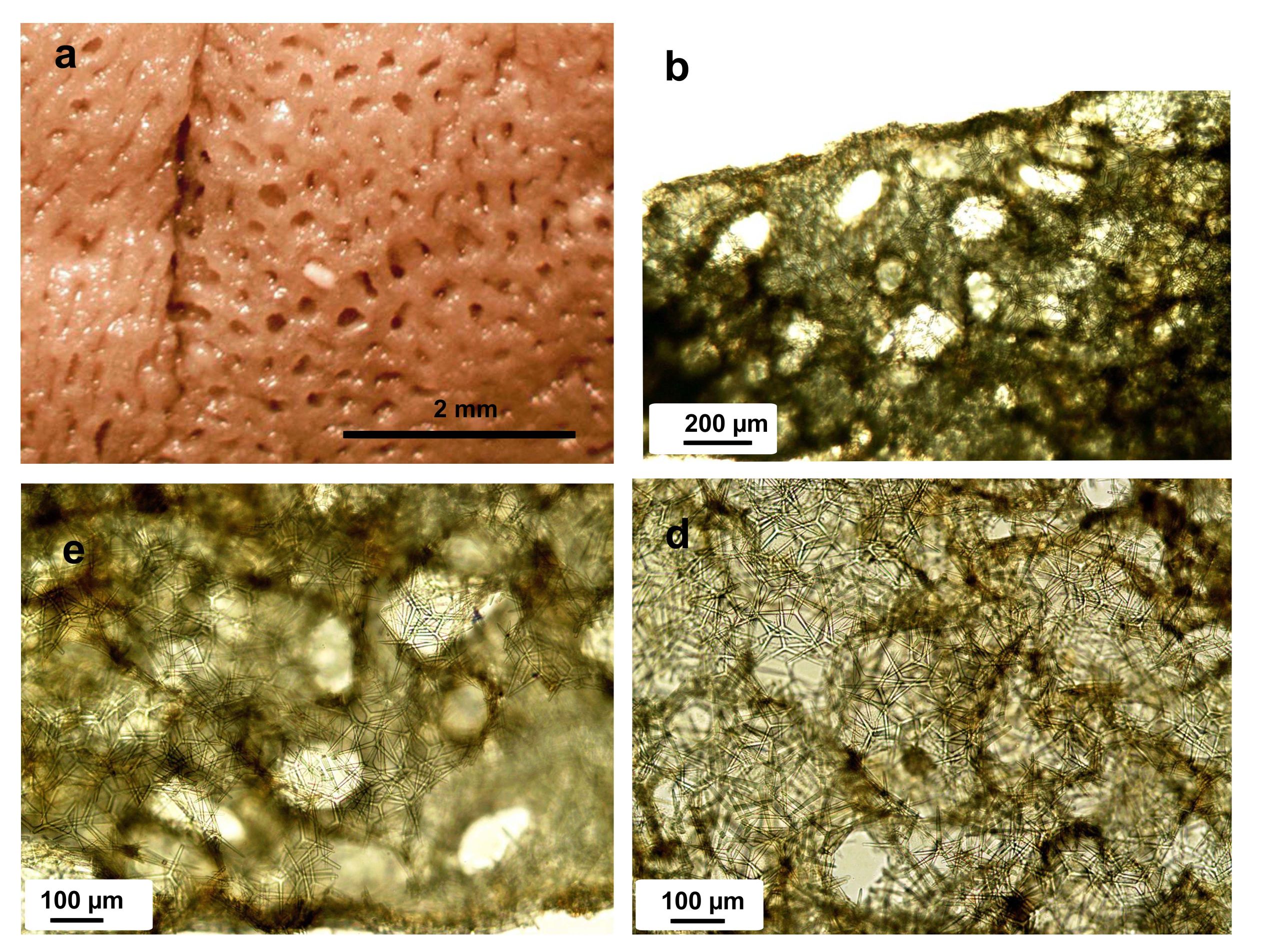the Sponge Guide - www.spongeguide.org
Observed Characteristics:
yellow
encrusting
massive
crumbly
soft
Bahamas
United States
Species Description and Notes
Description: Small irregular masses a few cm in width and about 1 cm high, isolated or in groups, bright yellow in color. The body is made up of a network of tightly anastomosed thin tubes, 50-300 µm in diameter, surrounding similarly sized meshes, appearing to the unaided eye as an almost compact body punctuated regularly by pores. Oscules have paper thin membranes and are located atop the masses, often aligned on the upper ridges, and seem to be the water collecting tubes. There is not an outer membrane covering the mass of tubes; Tubes are lined tangentially by an up to 20-30 µm skeletal layer of 2-3 superimposed spicules. Spicules are calcareous triactines, equiangular, with conical actines, 75-90 µm long by 7-10 µm thick (at the base), usually equiradal but sometimes one slightly longer (parasagittal); actines have slightly sinuous to stair-stepped edges, and the tips are blunt. There are a few smaller triactines of equal shape to the larger, 10-20 µm long by 3-5 µm wide; it was not established if they conform a separate size category, as intermediate, 55 x 7.5 3-5 µm, were observed. A few raphide like hairs (trichoxea?) were observed, 63-65 µm long, and also fragments of possible broken trichoxea, 2-2.5 µm thick; these were not observed in the tissue sections and thus could not be determined if they are proper.
Notes: This species lives in the undersides of caves and corals in shallow water. It conforms to what Wiedenmayer (1977) and Rützler (1986) described respectively from the Bahamas and Bermuda as Clathrina coriacea, yellow in color and with exclusively triactine spicules. There are other records of yellow Clathrina with triactine spicules from the tropical and subtropical Western Atlantic, which may correspond to our present material. de Laubenfels (1950, Bermuda) and Little (1963, Florida Gulf Coast) used the name Leucosolenia canariensis, while Lehnert & van Soest (1998, Jamaica) used C. primordialis. As Clathrina canariensis (Miklucho-Maclay, 1868) (recently placed under genus Arthuria by Klautau et al. (2013) and C. coriacea (Montagu, 1814) are a valid species from the NE Atlantic and the Mediterranean, our and these records need another name. However, the only Caribbean Clathrina with only triactines currently known is C. hondurensis Klautau & Valentine, 2003, described from old material collected in Belize (Turneffe Islands). Its life color is not known, but it has larger spicules (106-156 x 16 µm vs. 75-90 x 7-10 µm in our material) and large, irregular and loosely anastomosed tubes (Klautau & Valentine, 2003). The present material seems to conform to a new species from the Caribbean and Brazil, being currently described by M. Klautau (pers. com.). There is another yellow species with exclusively triactine spicules, C. aurea Solé-Cava et al. (1991), from tropical and subtropical Brazil (Muricy et al., 2011), but it differs from our material by having a looser arrangement of tubes and quite characteristic triactines with cylindrical actines and blunt ends (Klautau & Valentine, 2003; Lanna et al., 2007; 2009). The present species could be confused in the field with Clathrina sp.1-"yellow with tri- and tetractines", also pictured in this guide, which is a yellow cryptic species, but differs in having a looser arrangement of tubes and tetractine in addition to triactine spicules.
Tissue and Spicule Images

Spicule Images: a) Triactines; b) small triactines (few); c) triactine with a slightly larger actine (left, called parasagittal). Sample from the Bahamas.
Source Specimen: http://www.spongeguide.org/ thumbs/00024/00982.JPG

Tissue Images: a) External view of the tightly anastomosed tubes (clathroid cormus), forming the body of the sponge; b) microscopic view of a cross section of the body; c) and d) enlarged view of the tube linings. Sample from the Bahamas.
Source Specimen: http://www.spongeguide.org/ thumbs/00024/00982.JPG
Images
Clathrina sp.2-“yellow with only triactines”
Location: Bahamas, Little San Salvador
Photographer: Micha Ilan
Location: Bahamas, Little San Salvador
Photographer: Micha Ilan
Location: Bahamas, Little San Salvador
Photographer: Sven Zea
![<i>Clathrina </i> sp.2-“yellow with only triactines” <br />[United States, Florida Keys]](thumbs/00109/01334.jpg)
Location: United States, Florida Keys
Photographer: Joseph Pawlik
![<i>Clathrina </i> sp.2-“yellow with only triactines” <br />[United States, Florida Keys]](thumbs/00110/01352.jpg)
Location: United States, Florida Keys
Photographer: Joseph Pawlik